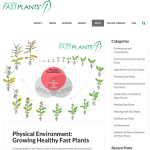Blogpost - Physical Environment: Growing Healthy Fast Plants
Read this blog post for background information about the relationship between the physical environment and life processes and systems in Fast Plants.
Growing healthy Fast Plants is easy if you understand how the environment can affect growth and development. Three broad categories of environmental factors influence how an individual plant matures through its life cycle:
1) the physical environment,
2) the chemical environment,
3) the biological environment.
Based on this information about standard conditions for optimal Fast Plants growth, one could easily design a wide variety of controlled experiments. Questions naturally arise while reading about optimal conditions that could be investigated by designing an experiment to how varying one condition affects growth, development and/or reproduction.
This blog post is part of a series explaining how key environmental factors "physical, chemical, and biological" can impact the growth of Wisconsin Fast Plants.
- NGSS.HS.LS4.5 Evaluate the evidence supporting claims that changes in environmental conditions may result in: (1) increases in the number of individuals of some species, (2) the emergence of new species over time, and (3) the extinction of other species. [Clarification Statement: Emphasis is on determining cause and effect relationships for how changes to the environment such as deforestation, fishing, application of fertilizers, drought, flood, and the rate of change of the environment affect distribution or disappearance of traits in species.]
- NGSS.MS.LS2.3 Develop a model to describe the cycling of matter and flow of energy among living and nonliving parts of an ecosystem. [Clarification Statement: Emphasis is on describing the conservation of matter and flow of energy into and out of various ecosystems, and on defining the boundaries of the system.] [Assessment Boundary: Assessment does not include the use of chemical reactions to describe the processes.]

Comments